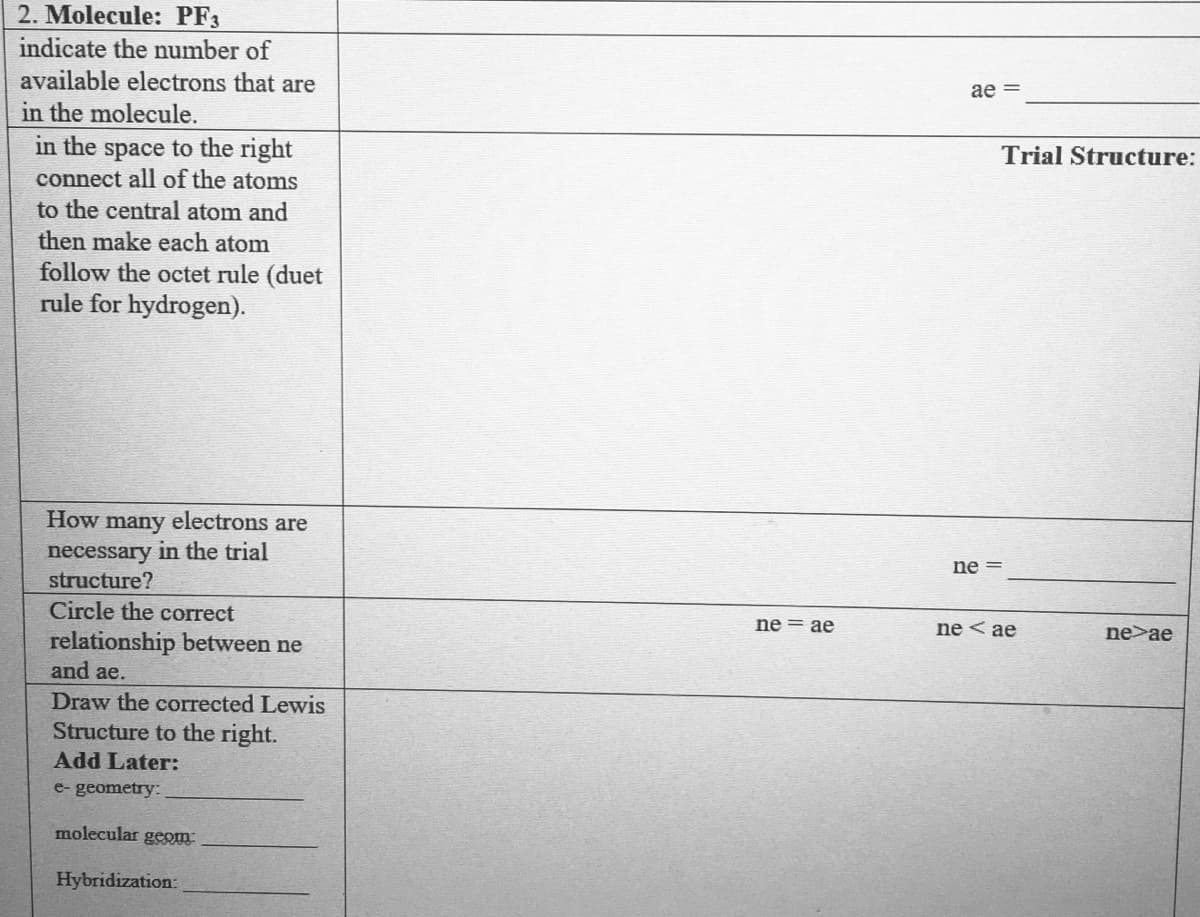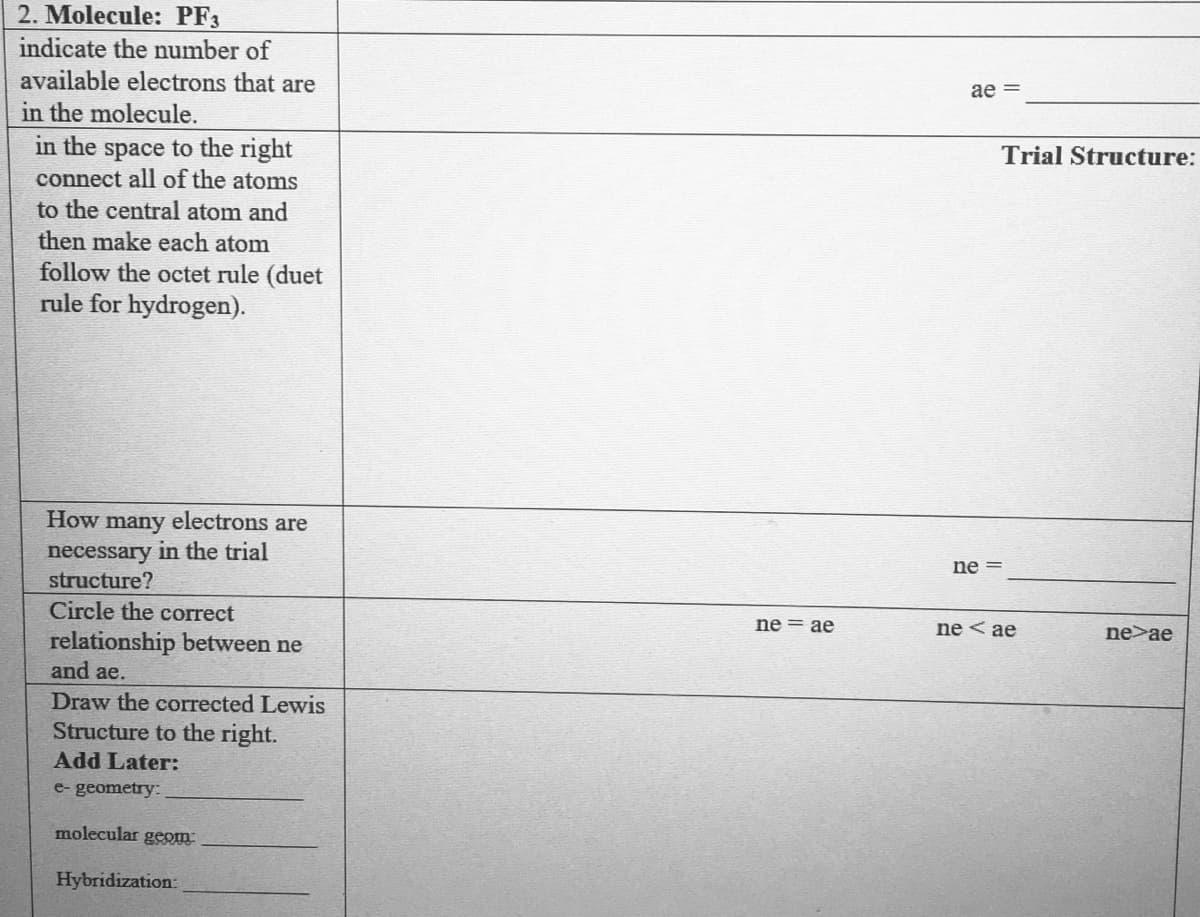Molecule: PF3 indicate the number of available electrons that are ae = in the molecule. in the space to the right connect all of the atoms Trial Structure to the central atom and then make each atom follow the octet rule (duet rule for hydrogen). How many electrons are necessary in the trial structure? ne = Circle the correct ne = ae ne < ae ne>ae relationship between ne and ae. Draw the corrected Lewis Structure to the right. Add Later: e- geometry: molecular geOm Hybridization:
Molecule: PF3 indicate the number of available electrons that are ae = in the molecule. in the space to the right connect all of the atoms Trial Structure to the central atom and then make each atom follow the octet rule (duet rule for hydrogen). How many electrons are necessary in the trial structure? ne = Circle the correct ne = ae ne < ae ne>ae relationship between ne and ae. Draw the corrected Lewis Structure to the right. Add Later: e- geometry: molecular geOm Hybridization:
Chemistry: Principles and Practice
3rd Edition
ISBN:9780534420123
Author:Daniel L. Reger, Scott R. Goode, David W. Ball, Edward Mercer
Publisher:Daniel L. Reger, Scott R. Goode, David W. Ball, Edward Mercer
Chapter10: Molecular Structure And Bonding Theories
Section: Chapter Questions
Problem 10.43QE: For each of the following molecules, complete the Lewis structure and use the VSEPR model to...
Related questions
Question

Transcribed Image Text:2. Molecule: PF3
indicate the number of
available electrons that are
ae =
in the molecule.
in the space to the right
connect all of the atoms
to the central atom and
then make each atom
Trial Structure:
follow the octet rule (duet
rule for hydrogen).
How
many
electrons are
necessary in the trial
structure?
ne =
Circle the correct
ne = ae
ne < ae
ne>ae
relationship between ne
and ae.
Draw the corrected Lewis
Structure to the right.
Add Later:
e- geometry:
molecular gEOm
Hybridization:

Transcribed Image Text:2. Molecule: PF3
indicate the number of
available electrons that are
ae =
in the molecule.
in the space to the right
connect all of the atoms
to the central atom and
then make each atom
Trial Structure:
follow the octet rule (duet
rule for hydrogen).
How
many
electrons are
necessary in the trial
structure?
ne =
Circle the correct
ne = ae
ne < ae
ne>ae
relationship between ne
and ae.
Draw the corrected Lewis
Structure to the right.
Add Later:
e- geometry:
molecular gEOm
Hybridization:
Expert Solution
This question has been solved!
Explore an expertly crafted, step-by-step solution for a thorough understanding of key concepts.
This is a popular solution!
Trending now
This is a popular solution!
Step by step
Solved in 6 steps with 2 images

Knowledge Booster
Learn more about
Need a deep-dive on the concept behind this application? Look no further. Learn more about this topic, chemistry and related others by exploring similar questions and additional content below.Recommended textbooks for you

Chemistry: Principles and Practice
Chemistry
ISBN:
9780534420123
Author:
Daniel L. Reger, Scott R. Goode, David W. Ball, Edward Mercer
Publisher:
Cengage Learning

Principles of Modern Chemistry
Chemistry
ISBN:
9781305079113
Author:
David W. Oxtoby, H. Pat Gillis, Laurie J. Butler
Publisher:
Cengage Learning

Chemistry: Principles and Reactions
Chemistry
ISBN:
9781305079373
Author:
William L. Masterton, Cecile N. Hurley
Publisher:
Cengage Learning

Chemistry: Principles and Practice
Chemistry
ISBN:
9780534420123
Author:
Daniel L. Reger, Scott R. Goode, David W. Ball, Edward Mercer
Publisher:
Cengage Learning

Principles of Modern Chemistry
Chemistry
ISBN:
9781305079113
Author:
David W. Oxtoby, H. Pat Gillis, Laurie J. Butler
Publisher:
Cengage Learning

Chemistry: Principles and Reactions
Chemistry
ISBN:
9781305079373
Author:
William L. Masterton, Cecile N. Hurley
Publisher:
Cengage Learning

Organic Chemistry: A Guided Inquiry
Chemistry
ISBN:
9780618974122
Author:
Andrei Straumanis
Publisher:
Cengage Learning

Chemistry & Chemical Reactivity
Chemistry
ISBN:
9781337399074
Author:
John C. Kotz, Paul M. Treichel, John Townsend, David Treichel
Publisher:
Cengage Learning

Chemistry & Chemical Reactivity
Chemistry
ISBN:
9781133949640
Author:
John C. Kotz, Paul M. Treichel, John Townsend, David Treichel
Publisher:
Cengage Learning